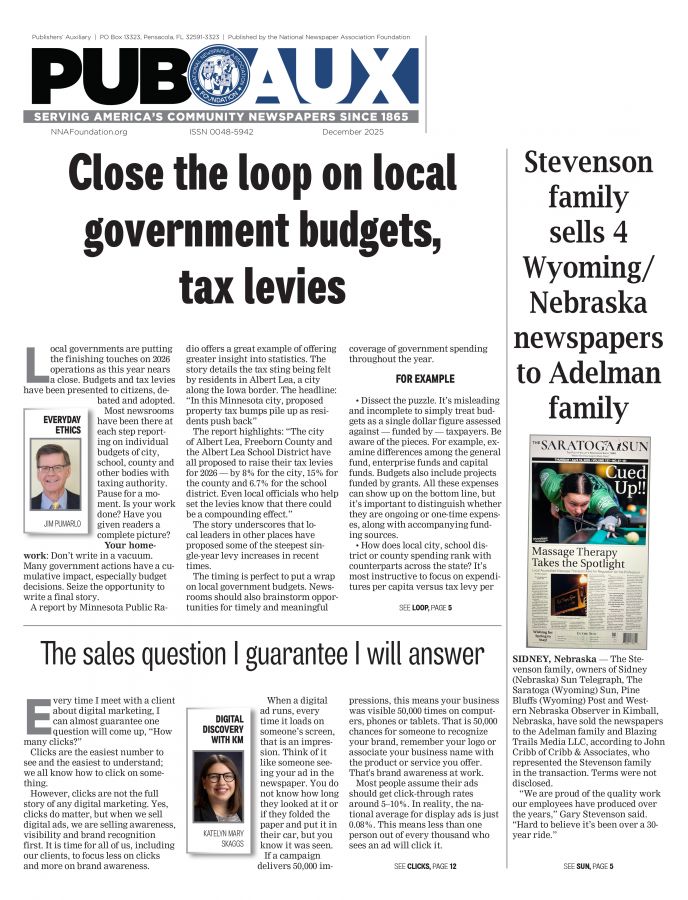Editorials can serve variety of roles
Jim Pumarlo
Aug 1, 2023


Newspapers regularly report items that are unflattering to the newsmakers. You have a responsibility, for example, to identify businesses cited for selling tobacco or alcohol to underage youths, especially if fines are assessed at a public meeting. Still, the reports will likely draw wrath from the businesses and their employees.
In contrast, newspapers can be selective in topics addressed on the editorial page. Weighing in on a sensitive community issue is not welcomed by all, such as endorsing or opposing a housing development or tax incentives for a big-box retailer.
Publishers and editors who view the editorial page as the heart of a newspaper take those stances, fully understanding the potential repercussions. That does not mean editors should advance positions with reckless abandon. Editorials should be thoroughly researched, reasoned and crafted. In the community press, it’s a greater challenge when writing about issues that involve individuals you associate with on a regular basis.
Editors often feel the burden of publishing editorials that attempt to solve the problems of their worlds — their communities. In truth, editorials serve a variety of roles.
First, they educate. What are the current housing rental codes, and how would they be strengthened under a proposed ordinance?
What’s the process, and the pros/cons, for annexing land to a city?
Second, they enlighten. Newspaper editors feel obligated to promote participation in the annual city festival. Take the opportunity to underscore the impact of tourism on the local economy.
Third, they entertain. An editorial might pose New Year’s resolutions for community leaders or even offer comment on a light-hearted moment at a city council meeting.
Editorials often challenge personal beliefs. Or they might reinforce readers’ positions, prompting an exclamation, “Now that editorial makes sense.” They can elicit a range of emotions — frustration, anger, laughter or tears.
Common to all effective editorials, however, is that they leave an impression. In contrast, nondescript editorials are easily forgotten and have little impact.
Following are some principles to consider when crafting editorials:
GET OFF YOUR IVORY TOWER
Editorials should not be positioned as the “correct” opinion or the last word. Editorials, at their best, should present a reasoned, researched and well-thought-out position.
WELCOME REBUTTALS
Newspapers should readily publish contrary opinions. Point/counterpoint is at the heart of vibrant editorial pages. Every editor can point to letters stronger than the original editorial. Resist having the final say via an “editor’s note” unless a letter contains some egregious error in fact.
STRIVE FOR CONSISTENCY
Editorials should be unwavering in promoting common themes. Newspapers often are labeled — even criticized — for promoting a conservative or liberal agenda. But newspapers that regularly flip-flop on issues will lose their credibility. That requires carefully thinking through positions, especially when an issue initially surfaces. At the same time, be open to revisiting a topic and altering your stance if circumstances significantly change.
OFFER KUDOS, TOO
Don’t hesitate to write complimentary editorials. Newspapers should not shy away from their role as a government watchdog. However, you’ll lose credibility — and quite possibly damage your communication and relationships with key individuals — if governing boards are always on the receiving end of an editorial rant and rave.
KEEP IT LOCAL
Editorials can be localized the same as news stories. For example, do rural school districts fare better than urban and suburban districts under proposed state legislation? Are local legislators’ votes representing the best interests of their constituencies?
ISSUE CALLS TO ACTION
Editorials are best when they can offer direction. For example, a city council is considering tax incentives for a proposed business expansion. Write an editorial on what you believe is best for the overall community good. A sidebar might educate readers on how tax incentives have been beneficial or detrimental to other communities.
BE AWARE OF BALANCING ACT
Editors and publishers often fill a vacuum in community leadership and find themselves at the forefront of civic initiatives. Coverage of editors and other employees “in the news” should be held to the same standards as any other newsmaker. Clear-cut conflicts of interest should be stated in editorials. At the same time, the strongest editorials are due to an involved newspaper staff. It’s impossible and impractical to carry a footnote for every conflict of interest, real or perceived.
Editorials are the best example of leadership by community press, and that includes tackling the tough and sensitive issues. It’s easy to be a community booster and join the bandwagon in applauding a high school sports championship. It’s more challenging and fulfilling to propose stiffer academic standards for student athletes. In the end, you’re fulfilling your responsibility of a newspaper, and you’re doing your community a service.
Jim Pumarlo is former editor of the Red Wing (Minnesota) Republican Eagle. He writes, speaks and provides training on community newsroom success strategies. He is author of “Journalism Primer: A Guide to Community News Coverage,” “Votes and Quotes: A Guide to Outstanding Election Coverage” and “Bad News and Good Judgment: A Guide to Reporting on Sensitive Issues in Small-Town Newspapers.” He can be reached at www.pumarlo.com and welcomes comments and questions at jim@pumarlo.com.










